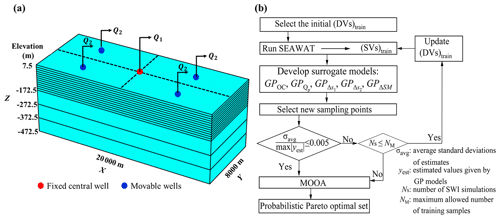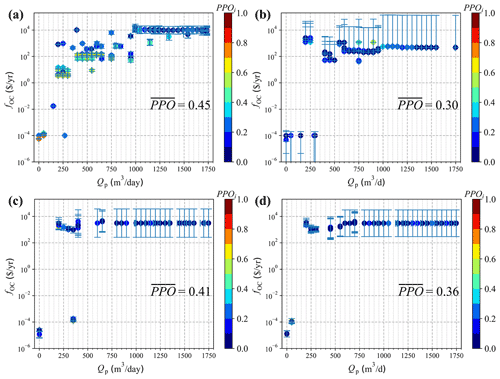An Efficient Surrogate-based Multi-objective Optimisation Framework with Novel Sampling Strategy for Sustainable Island Groundwater Management
In groundwater pumping optimization (GPO), offline-trained data-driven surrogates can be used to replace numerical-intensive simulators in order to save computing time. The traditional offline training approach involves building surrogates prior to optimization, fitting training datasets that cover the input space uniformly or randomly, which can prove inefficient due to the potential oversampling of low-gradient areas and under-sampling of high-gradient areas. This study proposes an offline machine-learning (ML) algorithm that ranks candidate training points by scoring them based on their distance to the closest training point and on the local gradient of the surrogate estimate and then choosing the highest-rank point. This method is applied to develop surrogates for solving a two-objective GPO problem formulated on a three-dimensional (3D) island aquifer, using hydrogeological conditions representative of San Salvador Island, Bahamas. The objectives are to minimise the supply cost (fOC) resulting from groundwater pumping and desalination and maximise fresh groundwater supply (Qp), subject to constraints on seawater intrusion (SWI) control expressed in terms of aquifer drawdown Δs at pumping locations and aquifer salt mass increase ΔSM. Gaussian Process (GP) is the technique applied to construct surrogates of objectives and constraints, alongside the estimation of uncertainties. Using GP models, it is possible to estimate the probability of “Pareto optimality” for each pumping scheme by Monte Carlo simulation. Pareto optimal pumping schemes (POPS) are then characterized by a probability of occurrence, which can be verified by numerical simulation. The GP training strategy's effectiveness in generating POPS is compared to traditional training approaches, showing that such a strategy can efficiently identify reliable POPS.








